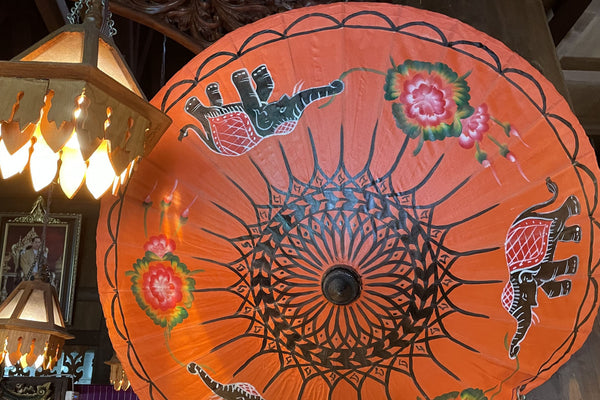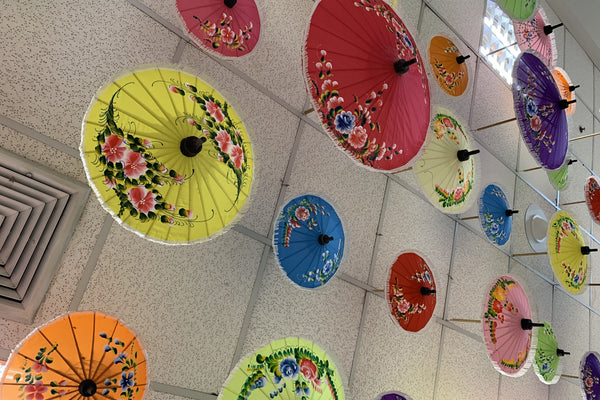How to identify genuine domestic Japanese umbrellas! I compared Japanese umbrellas made in Japan and those made overseas.

Even if they are called "Japanese" umbrellas, are they made overseas? What is the difference between foreign-made Japanese umbrellas sold under names such as wagasa, karakasa, and bangasa, and Japanese-made Japanese umbrellas?
Did you know that there are many different types of umbrellas in the world?
There are umbrellas other than Japanese umbrellas that are made from natural materials such as paper and bamboo. The methods of making and designs vary, and each one reflects the individuality of the country (land), so there are many discoveries to be made.
This time, we will focus on the differences between Japanese and foreign-made products that are close to us!
Foreign umbrellas are actually all around us! Observe the differences between them and Japanese umbrellas

In this article, overseas-made umbrellas refer to umbrellas made using natural materials that are manufactured overseas.
It seems that most of the production areas are in Asia, such as China, Thailand, and Myanmar.
In particular, umbrellas from Japan's neighboring country, China, are also called "oil paper umbrellas" or "Chinese umbrellas," and are imported and sold in Japan.
(*Below, Chinese umbrellas will be referred to as Karasa to distinguish them from Japanese umbrellas.)
However, these Karakasa are sometimes displayed in stores as "Wagasa" (traditional Japanese umbrellas), and some people may purchase them thinking they are Japanese umbrellas made in Japan.
So, what is the difference between a Japanese umbrella and a Chinese umbrella? Sadly, the reality is that there is little information available to help people understand the difference, and it's rare to find an ordinary person who can explain it.
I hope this article will help you learn about the differences and enjoy the unique personalities that come with each country's culture!
Please see our separate article for the history of Japanese umbrellas.
- A look back at the history of Japanese umbrellas, a Japanese tradition
- What is a bangasa? A thorough explanation of its history and characteristics!
[First of all] What is the "karakasa" that we will compare the differences between today?
A karakasa has a thick rib and grooves are dug into the rib to insert the small ribs.
It is said that modern Japanese umbrellas were made after the Chinese umbrellas were introduced and the unique Japanese craftsmanship was perfected to reach their current form.
In this article, we will use the Chinese umbrella shown in the photo below to look at three main differences between Japanese umbrellas and Chinese umbrellas!

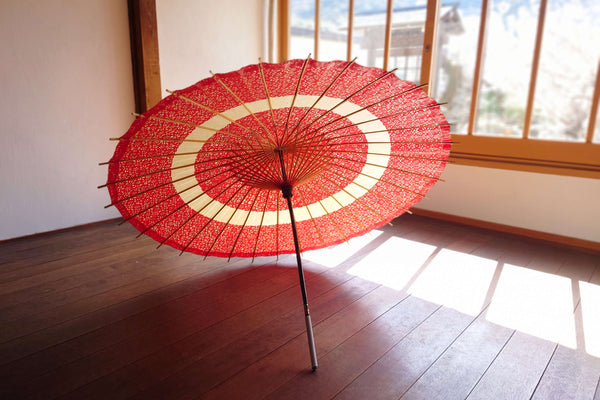
● Connection between the rib and small bones
* "Oyabone" = The longest bamboo frame "Kobone" = The short bamboo frame that supports the inside
An easy way to tell the difference is to look at the ribs visible from the inside of the umbrella.
Both Japanese umbrellas and Chinese umbrellas have a framework made up of ribs and small ribs, but the parts where these two are connected are different.
Japanese umbrella connection
↓A hole is made in the bamboo joint of the rib, and the small bone with the tip split is placed in the bamboo joint of the rib.
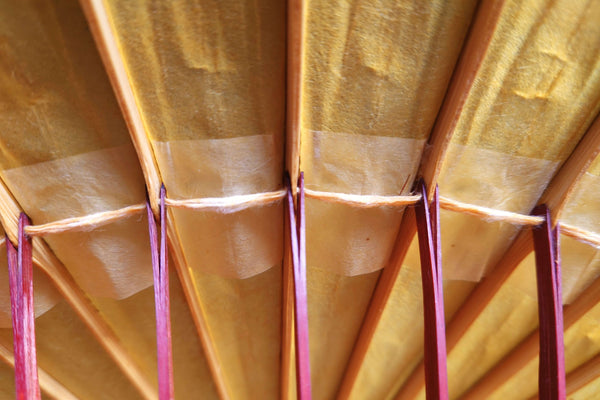
Umbrella connection
↓Make the rib thick, dig a groove, and insert the small bones into it.

Japanese umbrellas utilize the bamboo nodes in the main ribs, which are then clamped between smaller ribs that have been split in half to connect the ribs.
This makes the bone itself thinner, resulting in a beautiful closed triangle.
A karakasa is made by creating grooves in the ribs and inserting the small ribs into them. The ribs themselves are made thick, so when closed, the umbrella has a slightly cylindrical silhouette.
Japanese umbrella (left), Chinese umbrella (right)
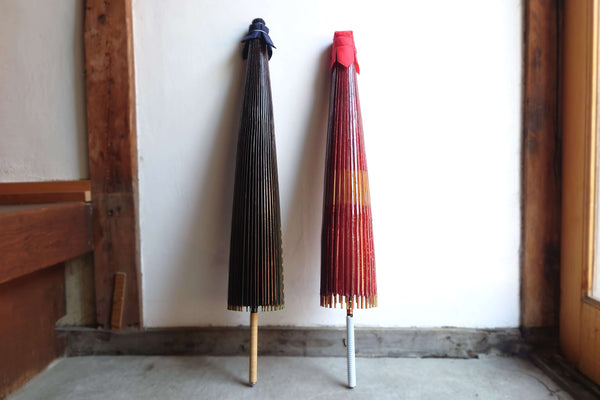

*If the manufacturing of Japanese umbrellas is outsourced overseas (teaching Japanese manufacturing methods) and the finished products are then imported, it may be difficult to tell the difference just by looking at the ribs. Please keep this in mind as a reference only.
● Stone foot
Japanese umbrellas are placed with the handle facing down. The bottom part of the handle that touches the ground is called the "stone tip." Let's compare them...
Japanese umbrella ferrule


Umbrella's ferrule
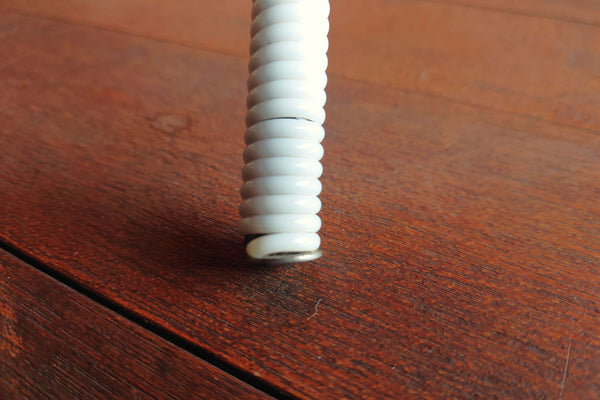
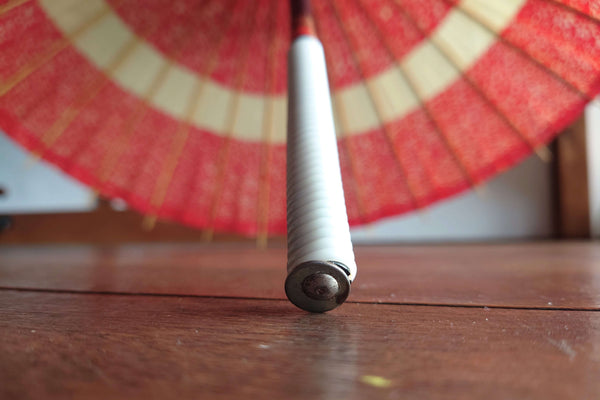
The ferrule of a Japanese umbrella wraps around the end of the handle and is shaped so that it is slightly off the ground.
Even the wooden handles, which are made from natural materials, are protected from damage.
On the other hand, because the Karakasa umbrella is shaped like a thumbtack, it is closer to the ground and the tip of the handle is more likely to get wet and damaged. Also, if the ferrule rusts, the handle may break. It seems best to use this type of ferrule to avoid getting it wet as much as possible.
In fact, this part called the ferrule is also found on Western-style umbrellas!
In the case of a Western-style umbrella, this refers to the top tip of the umbrella when it is opened.
Japanese umbrellas and Western umbrellas are held upright in different orientations, but what's interesting is that they both have the common rule of "placing the base facing down"!
(Some Japanese umbrellas do not have ferrules depending on the handle.)
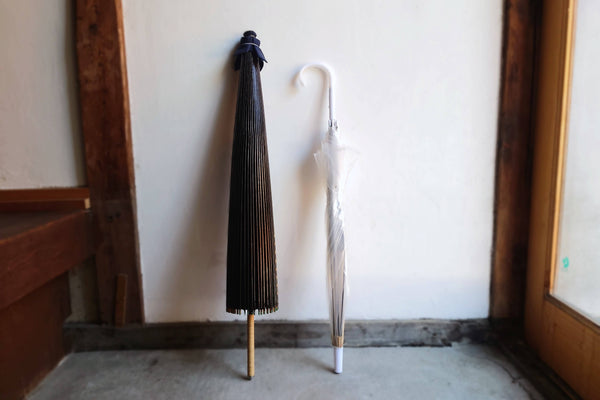
● Potwheel
The most important part in making an umbrella, the wheel, also has a different shape for Japanese umbrellas and Chinese umbrellas.
It's hard to tell because it's not very noticeable once the umbrella is completed, but please take a close look at the inside of the umbrella.
The joints of the head wheels of a Japanese umbrella are recessed from the outside to the inside, but the surface of the joints of the head wheels of a Chinese umbrella is flat. The shape and grooves of the mating wheels of the handles are also different.
Japanese umbrella head wheel and hand wheel
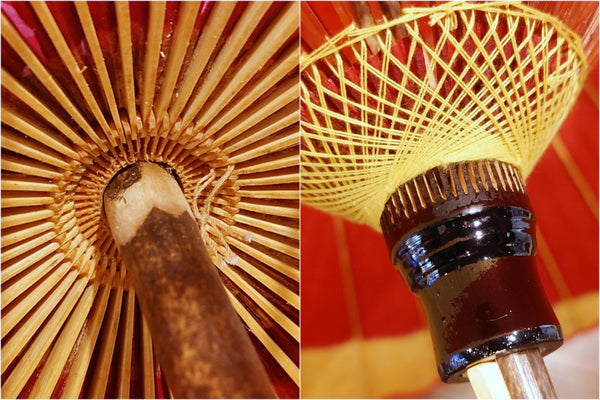
Umbrella head wheel and hand wheel

The differences are hidden even in places like this!
Let's take a look at how Chinese umbrellas are made!
We have introduced the Chinese umbrella in comparison with the Japanese umbrella.
There is a video of the production process on YouTube, so if you are interested, please take a look. (The production process in the video is just one example.)
Video-1 | How to make a Chinese umbrella (oiled paper umbrella)
How the Ancient Chinese Umbrella Was Made
Video-2 | How to make a Chinese umbrella (oiled paper umbrella)
Oilpaper Umbrella, It Takes Two Months to Make, Completely Handmade
Umbrella making in Thailand and Myanmar
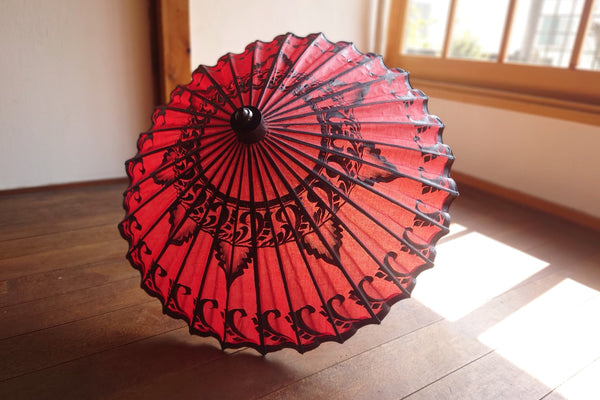
In addition to the Chinese umbrellas, there are many other umbrellas made from natural materials in Asia. There are many colorful umbrellas, so it's fun to look at them!
Video-3 | Umbrella Making Center, Bo Sang Village, Chiang Mai, Thailand
Umbrella Village
Chiang Mai, Thailand is famous for its umbrellas. At the Bo Sang Umbrella Festival, umbrellas fill the streets! Umbrellas! Come and experience the unique Asian atmosphere and the different way umbrellas are used than in Japan.
Video-4 | Pathein, Myanmar
Pathein Htee (Pathein Umbrella)
Video-5 | Pathein, Myanmar
DVB - Fashion Wave (Pasteurized Umbrella)
Check out this page to see how Japanese umbrellas are made!
Umbrellas from around the world are filled with culture and history
This time, we have focused on the differences between familiar Japanese and foreign-made products.
I hope you will take this opportunity to learn about the differences in how they are made.
There are many different types of umbrellas around the world, and they continue to be made today as local handicrafts.
It might be a good idea to plan a trip to see umbrellas from all over the country.
